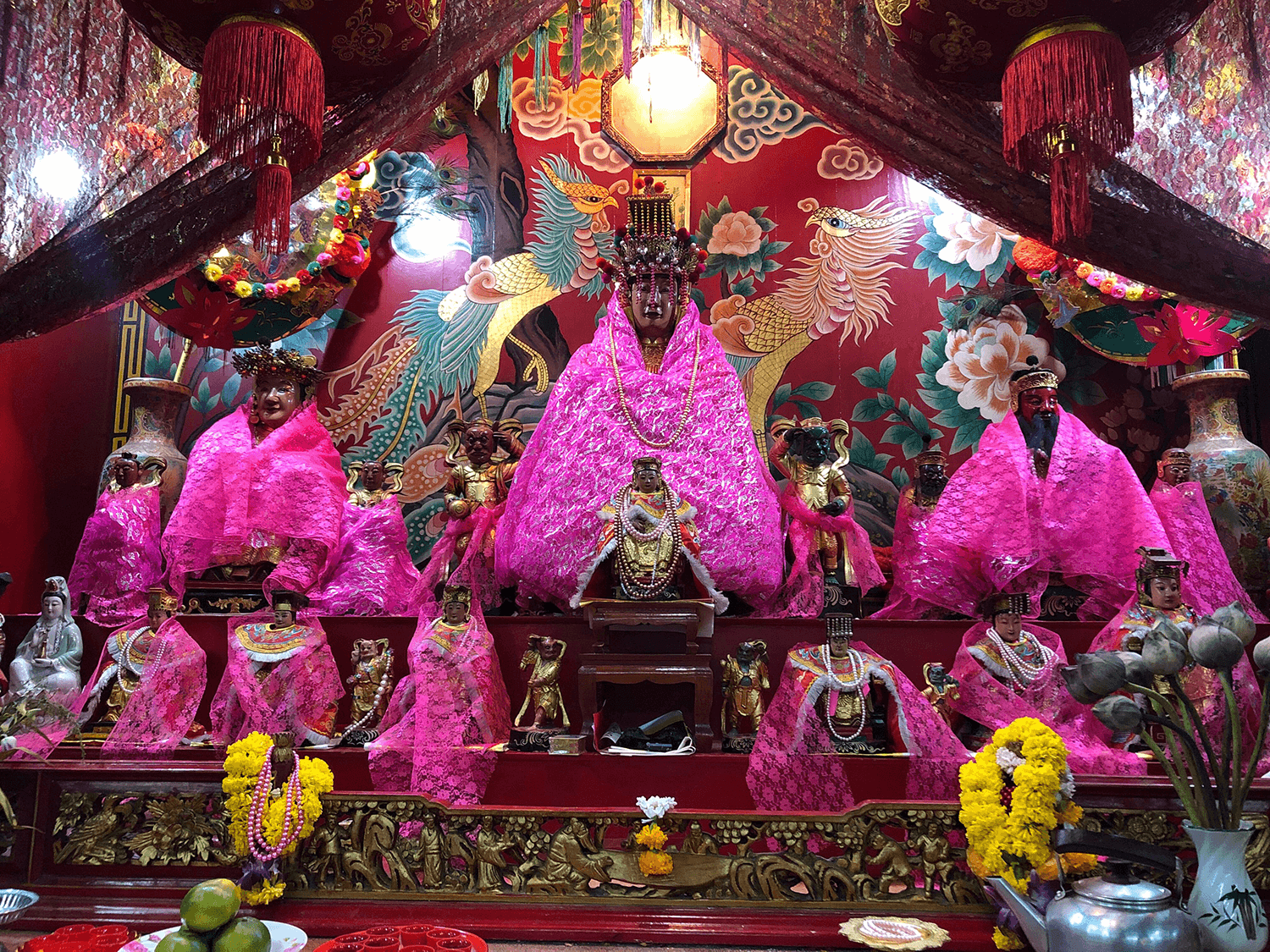Nearly two centuries ago, when Chulalongkorn was king, a man spotted something stuck in the whirling waters of a Bang Rak canal, back before it was paved over to become Charoen Krung Road.
There it was trapped in surging waters for three days and nights before he recognized it was the statue of a goddess. He later gave it to his brother, Chu Thang, who owned a chicken farm nearby in Saphan Luang, an area now known for street food stalls and low-slung buildings along Rama IV Road.
In the 1880s – the exact year has been forgotten – the family built a shrine on the farm and put the statue inside it. There, the fertility goddess Tubtim became well-respected among generations of Thai-Chinese for granting wishes – especially babies – and delivering warnings in their dreams.
There it remains today along with the latest in a line of caretakers stretching all the way back to Chu Thang, despite the repeated efforts to demolish the shrine and evict its keepers stretching back over half a century.
On a recent afternoon, Penprapa “Nok” Ploysrisuay sat on an ottoman in front of the statue’s smoldering censers as she recalled history handed down through generations of caretakers, now preserved on sheets of computer-printed paper.
Penprapa has cared for the shrine since her husband Pathompong Ploysrisuay, its third-generation caretaker, died two years ago.
Now living there with her mother and three children, that means sweeping its front yard, giving the statue offerings and lighting incense and candles anew every morning.
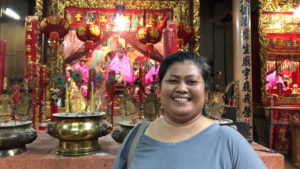
The Last Caretaker?
They remain there now despite a final eviction date handed down earlier this month on June 15 by Chulalongkorn University, which owns that and much more land in the surrounding area. The university is eager to get started on stalled plans to redevelop the plot into luxury condominiums.
As the university founded by King Chulalongkorn ratchets up pressure for them to go, Penprapa says she’s willing to do so, despite the fact the shrine predates the university by decades. But she insists it must treat them honorably, help them through the transition and provide a safe living environment at the shrine’s new location.
“You should come and talk to us properly. You have a lot of lands, you could give us a room or build your condominium behind our shrine or even move your condo project to somewhere else,” she said, adding that she never got proper documentation of the eviction nor the opportunity for a serious sit-down with the school’s property management executives.
The university says it has generously offered to pay for six months of accommodation until a new shrine is finished in December by a nearby park.
Chula still set on demolishing historic shrine – once it evicts caretakers
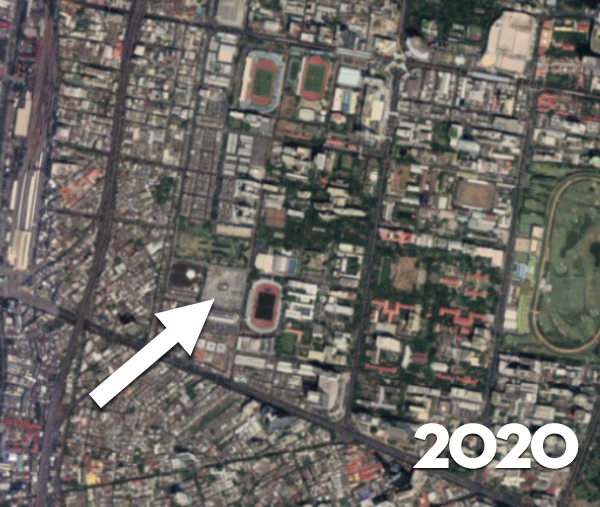
Penprapa said the university in fact only offered to cover half of the THB30,000 monthly rent for six months of accommodations while a new structure is built by the park. She also described the accommodations as “shabby” and “worn-out,” and said the university told them they would have to pay to make it habitable.
She also doubts the school won’t later separate them anyway from the goddess she calls Ama (grandmother, to the Thai-Chinese).
“They said they’re going to build a new shrine for Ama at Centenary Park, but the park is far from fully finished, and there are lots of snakes in that place,” 42-year-old Penprapa said. “And from what I hear, the buildings in the area they’re providing for us to stay will be served with eviction notices soon in the future as the university refuses to renew their leases.”
Earlier this month, student activists staged several protests urging the university to halt the demolition. With public and media attention high, the university didn’t move forward as planned, but said it will begin tearing it down soon.
Those advocating for its preservation say the shrine is important local heritage to residents in the community.
Penprapa says every occasion from Chinese’s New Year to Songkran used to be celebrated there. Each generation of caretakers cooked for people in the community, Chinese opera troupes battled each other before audiences, and films were shown outdoors as entertainment tributes from the community to the goddess.
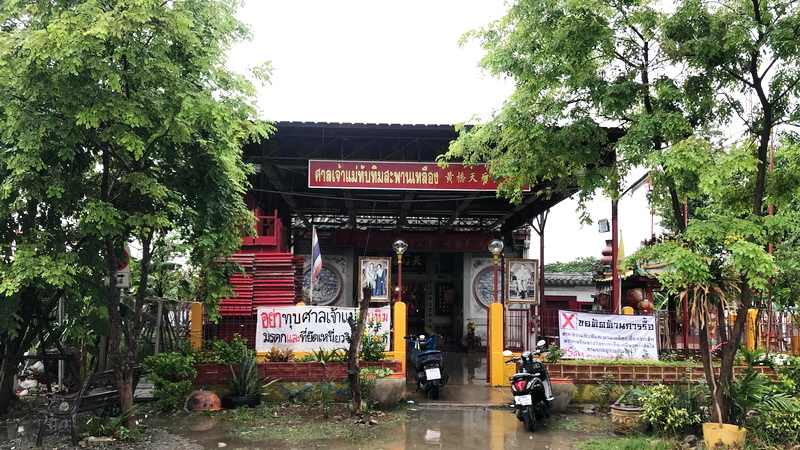
Divine Interventions
This isn’t the first time the university has tried removing the shrine.
Years ago, the shrine wasn’t as isolated. It had a thriving community around it, at least until 2007 when Chula served eviction notices to its neighbors.
Their pleas to stay were rejected. Though the shrine endured, it was left standing alone, surrounded by empty plots that became used to park cars. The opera troupes stopped coming in 2013.
Fifty years earlier, in 1957, Chula had moved to evict a much wider swath between what is today the National Stadium down to Rama IV Road for redevelopment. The densely populated community staved off the eviction threat, but after one of the city’s biggest fires ever broke out three years later between where the stadium now stands down and Soi Chula 12, rumors spread it was arson.
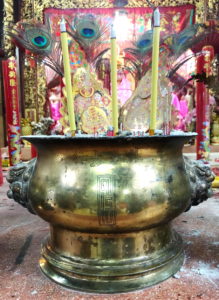
But the shrine survived even that. After the fire, the damaged area was rebuilt with commercial buildings, mostly selling spare auto parts. Many people moved out of Samyan, but the Tubtim shrine remained and even got a community-sponsored makeover.
On top of its local importance to residents, Penprapa says the shrine was made even more sacred by a very special visitor: university founder and monarch Chulalongkorn himself. According to history, Chulalongkorn visited it privately and upon his death in 1910, his successor Vajiravudh, styled Rama VI, gave the shrine a specially made censer that had been used in his father’s funeral. It remains in use there today, engraved in Chinese with the year it was given and both kings’ names.
Penprapa said, if necessary, she might use this as evidence of the shrine’s long history before the university was fully established seven years later. It said it proves the shrine’s importance and why they deserve respect as “those who come before.” She mentioned other evidence that she’s trying to collect to assert its historical precedence.
The last time she talked to university representatives was Wednesday. She said they gave no new demolition date and urged them to find alternative accommodations they would prefer.
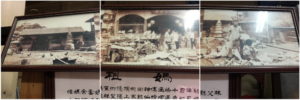
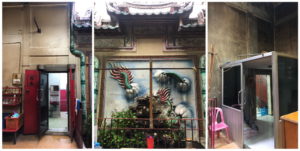
Related
Chula still set on demolishing historic shrine – once it evicts caretakers
Chulalongkorn set to bulldoze historic Chinese-Thai shrine, build condos
